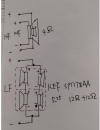Integrating the woofers to the cylinder might be a challenge, how would you attach the the drivers to the alu? (flat to curved isn't easy!) And will you create some sort of transition for smooth baffle integration? Though the integration part might be near insignificant, extrusions and sharp edges tend to be minimized to reduce diffraction, so at least for the coaxial and front woofers I'm guessing it would be worth it to do so.
Looks like cylinder should work well, but I'd double check given diameter, sometimes things aren't very intuitive!
For the crossover/amp, why so large btw? Personally, I'd just keep them separate from the speakers, which would allow maybe either a one piece cylinder or monitor+base, would probably be sleeker and easier!
Lastly, design is obviously omnidirectional, would that be really better than a sort of line array with woofers in front? Front drivers would allow cutting a flat front baffle for all the drivers. So the front baffle could be a flat alu sheet, which would allow drivers to be mounted flat, likely would make the build again easier? Plus as mentioned the sealed compartment inside the cabinet to seal the coaxial driver, could attach the front baffle. So for construction, the entire front flat baffle could be removed in one piece, then screwed to the cylinder. Something like this; for 4 woofers; other 4 could be in the bottom cabinet:
View attachment 418636
Check out the driver arrangements here;
https://www.speakerdesignworks.com/about-1 Ex; Uluwatu. Obviously not omnidirectional, but as kemmler mentioned given the challenges of omnidirectional design, if this is your first rodeo, going with a more traditional driver arrangement would likely be much easier?
For 8 drivers, as above, 4 could on top cabinet and the 4 others could be on the bottom cabinet, but that would mean that you would need 2 ports, one for top cab and one for bottom cab, unless it's one cabinet, then 1 port as Uluwatu would work too.
I don't see any port in either of your designs, so that would be something to factor too, unless you're planning a sealed design!




